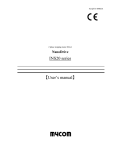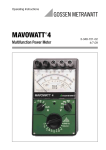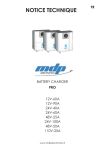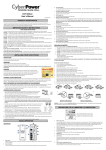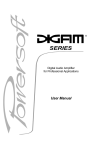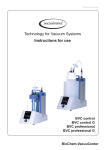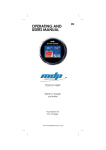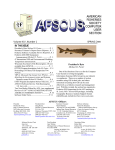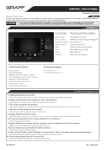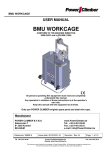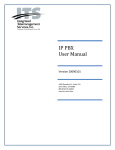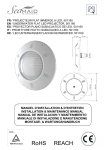Download user manual
Transcript
OPERATING AND USERS MANUAL DOLPHIN PRO Battery charger 24V40A REYA Code : 399160 24V60A REYA Code : 399170 24V100A REYA Code : 399180 12V60A REYA Code : 399140 12V90A REYA Code : 399150 UK SAFETY PRECAUTIONS SAFETY PRECAUTIONS NOT-DOLPROREYA-03 NOT-DOLPROREYA-03 TO PREVENT ANY RISK OF ELECTRIC SHOCK OR FIRE, READ THIS MANUAL CAREFULLY BEFORE INSTALLING THE EQUIPMENT. In the event of any problems or misunderstandings, please contact REYA. This equipment is not designed for use by people (including children) with diminished physical, sensorial or mental capacities, or people without experience or knowledge of such equipment, unless they have received prior instruction in the use of the equipment from a person responsible for their safety or are under the supervision of such a person. Ensure that children are supervised in order to prevent them playing with the device. This equipment contains components that may cause electric arcs or sparks, when connecting cables, for example. To prevent any risk of fire or explosion, do not install this equipment close to flammable materials, liquids or gases. Installation precautions. UK 4This device must not be exposed to running water, water spray and dust of any kind. 4We recommend securing the device in a vertical position, with the cable outlet pointing downwards. 4You are formally prohibited from making mechanical alterations to the housing, including making additional holes, for example. 4Under no circumstances should this device be seen as a toy. It should therefore, quite clearly, not be left in the hands of a child. Connection precautions. To prevent any risk of electric shock or irreversible damage to the equipment, you should comply strictly with the following recommendations. 4The installation to which this device is connected must comply with the applicable regulations. To prevent any risk of irreversible damage to the equipment, ensure that you comply scrupulously with the following recommendations. 4This device is designed to be connected to 220-240V 50Hz or 100-120V 60Hz single phase circuits. 115V / 230V selection is automatic. 220-240V only for 24V100A version. 4This device must not be installed close to a heat source. 4The mains power line must feature a cut-off device with differential protection, to protect individuals against electric shocks. Refer to the device’s electricity consumption characteristics to select the size and type of circuit breaker. 4It must not be installed in an airtight or badly-ventilated compartment. 4The ventilation inlets must not be obstructed. 4Clearance of at least 10 cm must be allowed around the housing to guarantee adequate convection. SAFETY PRECAUTIONS NOT-DOLPROREYA-03 4Prior to commencing connection, the mains cable gland in the packaging must be assembled and correctly attached to the housing (using the nut provided), in the hole designed for this purpose. 4For safety reasons, the device’s EARTH terminal (PE “Protective Earth” terminal), must be connected to the system’s physical earth (yellow & green wire of the mains cable). Refer to the wiring diagram for more information. 4To prevent parasite heating, ensure that the cable cross-sections are correct and the connectors are properly tightened. IMPORTANT : This device is not protected against battery polarity reversals. A battery connection error automatically causes the battery fuses to blow as well as irreversible damage to the circuit board. Activation precautions. To prevent any risk of electric shock on activation or during operation, the protective cover must be correctly positioned and screwed into the housing. This device complies with the applicable regulations governing transmitted interference and immunity from external disturbances (see EMC paragraph in the Technical specifications section). When in operation, take particular care that this device is not subjected to conducted or radiated interference at levels higher than the legal limits otherwise malfunctions may occur (e.g.: device too close to a powerful transmitter). SAFETY PRECAUTIONS UK NOT-DOLPROREYA-03 In other respects, this device transmits conducted and radiated interference at levels that comply with the applicable regulations. Ensure that other sensitive equipment used in the vicinity is compatible with this device otherwise malfunctions may occur. Device serial number The serial number appears on the grey or white sticker on one side of the device. This number is aligned vertically and comprises a first number indicating the year of manufacture (e.g.: 12 for 2012), a letter indicating the month of manufacture (e.g.: C for the month of March), as well as a 5-figure number that is the product’s individual serial number. Important Note on the choice of charge curve It is important to note that the use of an inappropriate charging cycle for the battery technology may extensively impair or even damage the latter. This is particularly true for cycles where the charge voltages are higher than the levels recommended by the battery manufacturers. Example: A serious risk of overheating the batteries and releasing gases that are harmful to users’ health. Curve no. 9 is compatible with a LiFeSo4 battery provided that the battery is equipped with BMS-type battery protection (Battery Management System) within the actual battery. In this case, refer to the battery manufacturer’s recommendations for the choice of charging cycle. GENERAL CHARACTERISTICS CONTENTS of the BOX NOT-DOLPROREYA-03 NOT-DOLPROREYA-03 Maintenance precautions RECEIPT OF THE PRODUCT To prevent any risk of electric shock during maintenance operations, ensure that the following recommendations are scrupulously observed before performing any maintenance on the device: Contents of the packaging 4The charger. 4Its user manual. 4All maintenance operations must only be carried out by a suitably qualified technician. 4Its mains cable gland accompanied by its mounting nut (to be installed on the housing prior to connection). 4In the event of damage to the mains leads and/or batteries, these may only be replaced by a qualified person, to avoid any danger. 4The mains power supply must be disconnected (cable or switch). 4 The -DC or -BAT supply on the battery must also be disconnected to prevent any transfer of power. 4To allow the high voltage capacitors to discharge (on the circuit board), wait for 5 minutes before carrying out any work inside the housing. 4The fuses must be replaced by fuses with strictly identical characteristics and performance levels. UK 4Its battery temperature sensor (24V100A version only) Checking Check the product’s identification label, attached to one side of the product, to ensure that the technical details actually meet your needs (mains supply voltage, charger capacity, etc.). Installation introduction The charger is attached using 4 x 4mm Ø screws (not supplied), to a “robust” mounting or wall. Ideally, the product should be in a vertical position, with the cable outlet pointing downwards. Clearance of at least 10 cm must be allowed around the device to guarantee optimum convection, in particular along the sides allowing the air needed for ventilation to flow in and out. The circulation and convection direction of the air inside the charger is from right to left, viewed from the front of the product (see photo below). CONNECTIONS CONNECTIONS NOT-DOLPROREYA-03 NOT-DOLPROREYA-03 Ventilation direction DETAILS OF CONNECTIONS warm cool CONNECTIONS To gain access to the charger’s connections, the front hatch must be removed. To do this, simply unscrew the screw on the front hatch. The hatch is removed by rotating it. Prior to commencing connection, the mains cable gland must be positioned and attached to the housing in the hole designed for this purpose (hole on the left, when viewed from the front of the product). The plastic nut supplied with the cable gland allows it to be attached to the housing. This nut is positioned on the inside of the housing. Ensure the correct tightening torque is applied. Mains cable gland Front hatch UK CONNECTIONS CONNECTIONS NOT-DOLPROREYA-03 NOT-DOLPROREYA-03 Marking Functionalities L1 AC mains phase, 10mm2 max (wire colour code: brown or black) N AC mains neutral, 10mm2 max (wire colour code: blue, white or red) PE AC mains earth, 10mm2 max (wire colour code: green & yellow or green) -DC battery negative (common), pin M8 (wire colour code: black) +DC1 Main battery positive, pin M8 (wire colour code: red) +DC2 Auxiliary battery 2 positive, pin M8 (wire colour code: red) +DC3 Auxiliary battery 3 positive, pin M8 (wire colour code: red) CHARGE SELECT Charge curve and battery charging mode selector, 10 positions (from 0 to 9) BATTERY FUSES Battery protection fuses (on the –DC supply) EXT COM1 External communication bus (CAN bus) (for an external digital display or communication between chargers) EXT COM2 External communication bus (CAN bus) (for an external digital display or communication between chargers) INT COM Communication bus for a digital display built into the charger TEMP SENSOR Battery temperature sensor (2 non-polarised wires, no direction) positioned on the positive terminal of the main battery REPLAY Dry alarm contact UK Example of connection on the basis of 3 distinct sets of batteries Important Check the quality of connections and proper tightening of connections. CONNECTIONS NOT-DOLPROREYA-03 NOT-DOLPROREYA-03 AC CABLES AND CIRCUIT BREAKER DC CABLES AND FUSES AC wiring DC wiring Check the quality of connections and proper tightening of connections. For mains power, preferably use a HO7RNF-type industrial cable. Ensure that you comply with the following recommendations. Charger capacity 220-240V AC 50Hz Length < 5m (16ft) 100-120V AC 60Hz Length < 5m (16ft) 12V 60A 2.5mm2 / AWG13 4mm2 / AWG11 12V 90A 2.5mm2 / AWG13 4mm2 / AWG11 24V 40A 2.5mm2 / AWG13 4mm2 / AWG11 24V 60A 2.5mm2 / AWG13 4mm2 / AWG11 AC 24Vcircuit 100A breaker 4mm2 / AWG11 6mm2 / AWG9 The AC mains power line must feature a cut-off device with differential protection, to specifically protect individuals against electric shocks. The circuit breaker’s sensitivity must be 30mA. Its current capacities comply with the charger’s power consumption. Comply with the following recommendations in this respect. Mains power 220240V 50Hz Mains power 100120V 60Hz 12V 60A 8A – 30mA 16A – 30mA 12V 90A 8A – 30mA 16A – 30mA 24V 40A 8A – 30mA 16A – 30mA 24V 60A 10A – 30mA 20A – 20mA 24V 100A 20A – 30mA - Charger capacity UK CONNECTIONS N.b. : The charger has an internal protection fuse on the L1 supply, in the event of a general fault on the circuit board in particular. Due to the irreversible nature of this fault, the fuse is not accessible for maintenance of any kind. Check the quality of connections and proper tightening of connections. Battery cables must be as direct and short as possible. Each battery output can provide the charger’s full amperage and all the cables must have identical cross-sections. Ensure that you comply with the following recommended cross-sections. Charger capacity Length < 2m (6ft) Length between 3 and 5m (10 to 16ft) 12V 60A 25mm2 / AWG3 35mm2 / AWG2 12V 90A 35mm2 / AWG2 50mm2 / AWG0-1 24V 40A 16mm2 / AWG5 20mm2 / AWG4 24V 60A 25mm2 / AWG3 35mm2 / AWG2 24V 100A 35mm2 / AWG2 50mm2 / AWG0-1 These chargers are equipped with airtight grommets with “automatic” opening. Simply pressing the central section of the membrane is sufficient to allow the cable to pass through the grommet. CONNECTIONS CONNECTIONS NOT-DOLPROREYA-03 NOT-DOLPROREYA-03 AC CABLES AND CIRCUIT BREAKER The performance and usable life of batteries are thereby maximised. DC fuses UK When maintaining the charger’s internal fuses, these must be replaced by fuses with strictly identical characteristics and performance levels. Risks of irreversible damage to the equipment. By virtue of fully automated charging cycles, the batteries are protected against surges, providing a permanent connection for the charger. Selection of the charging program takes place on installation using the “CHARGE SELECT” dial on the charger board. It is essential and highly recommended that you install, as close as possible to each positive output on the battery, a fuse to protect connections, specifically in the event of a short circuit and/or overheating of the battery cables, as the result of damage to the protective sleeves, for example. The position of the arrow indicates the number of the program selected (e.g.: program No. 1 in the photograph above). Selection is made using a small flat-head screwdriver. Charger capacity Internal charger fuse (–DC supply) External battery fuse (+BAT supply for each battery) 12V 60A 3 x 25A 32V rapid (mini automotive fuse) 80A 32V rapid 12V 90A 4 x 30A 32V rapid (mini automotive fuse) 100A 32V rapid 24V 40A 3 x 25A 32V rapid (mini automotive fuse) 60A 32V rapid 24V 60A 24V 100A 3 x 25A 32V rapid (mini automotive fuse) 5 x 30A 32V rapid (mini automotive fuse) 80A 32V rapid 150A 32V rapid CHARGE CURVE SELECTION The up-to-date digital electronics, based on an RSC microcontroller, monitor the charging process by optimising, the voltage, current and recharging time parameters, on the basis of the initial charge level of the batteries, using the exclusive “scanning charge” function. CAUTION It is important to note that the use of an inappropriate charging cycle for the battery technology may extensively impair or even damage the latter. This is particularly true for cycles where charge voltages are higher than the levels recommended by the battery manufacturers. A serious risk of overheating the batteries and releasing gases that are harmful to users’health. Curve no. 9 is compatible with a LiFeSo4 battery, provided that the battery is equipped with BMS-type battery protection (Battery Management System) within the actual battery. In this case, refer to the battery manufacturer’s recommendations for the choice of charging cycle. SETTINGS SETTINGS NOT-DOLPROREYA-03 NOT-DOLPROREYA-03 PROGRAMME PHASE 12V 24V 0 Open lead V. BOOST V. FLOAT 14,4V 13,2V 28,8V 26,4V 1 Airtight lead V. BOOST V. FLOAT 14,2V 13,6V 28,4V 27,2V 2 Lead calcium V. BOOST V. FLOAT 14,8V 13,8V 29,6V 27,6V 3 «Delphi» type V. BOOST V. FLOAT 15,4V 13,8V 30,8V 27,6V Charge curve 4 «Optima» type V. BOOST V. MAX V. FLOAT 14,8V 15,5V 13,8V 29,6V 31.0V 27,6V Wintering Open lead Charge curve 14,4V 13,2V 28,8V 26,4V V. BOOST V. FLOAT 14,2V 13,6V 28,4V 27,2V GEL & AGM V. BOOST V. FLOAT 14,4V 13,8V 28,8V 27,6V V. FLOAT 13,6V 27,2V V. FLOAT 14,4V 28,8V Charge curve 8 V. BOOST V. FLOAT Wintering Airtight lead Charge curve 7 Charge curve 5 6 UK Power supply Charge curve 9 LiFeSo4 + integrated BMS Charge curve UK OPERATION OPERATION NOT-DOLPROREYA-03 NOT-DOLPROREYA-03 BATTERY TEMPERATURE SENSOR LED DISPLAY The temperature sensor allows the charging voltage to be adjusted depending on the battery temperature. The PRO charger is equipped with a local multifunction LED display, which, among other things, shows the details of the key stages of the battery charging process. It therefore allows the usable life of batteries to be increased, mainly in the event that the ambient temperature in the battery area is high. This sensor is screwed onto the main battery’s positive terminal (a service battery as a general rule). The 2 wires are connected to the “TEMP SENSOR” connector on the charger board (in no particular direction). The compensation level is around +/-25mV per °C for a 24V battery and between +/-12mV per °C for a 12V battery (see curves below). Charging voltage Reference voltage BOOST phase : the battery is in its recharging phase, reaching a level of charge of close to 80%. This recharging phase is limited to a period of 6 hours. ABSORPTION phase : The voltage is maintained and the amperage is reduced until the battery returns to a level of charge approaching 100%. This phase is limited to a period of between 30 minutes and 4 hours, depending on the battery’s initial charge level. FLOAT phase : the voltage and the amperage are reduced to maintain the battery. During the Floating phase the charger only delivers what the battery strictly needs. In other respects, the key faults (temperature, fuse, voltage, etc.) are also taken into account and shown by the LED display. Screen Battery temperature in °C The resistor connected initially simulates a temperature of 25°C. The action of the battery temperature sensor allows the charge to be adjusted, upwards or downwards, depending on the battery temperature, i.e.: +/- 15 mV per °C at 12 V +/- 30 mV per °C at 24 V OPERATION OPERATION NOT-DOLPROREYA-03 NOT-DOLPROREYA-03 UK Modes and display scenarios MODE MEANING SOLID LED INITIALIZATION Charger powered on and/or Change of charging cycle All LEDs for 3 seconds ABSORPTION PHASE Batteries in recharging phase (charge from 0 to 80%) EQUALIZATION PHASE FLOATING PHASE MAINS VOLTAGE FAULT Batteries in recharging phase (charge from 80% to 100%) End of the equalisation cycle within a period of 30 minutes Charging cycle completed (charge at 100%) FLASHING LED POWER ON POWER ON ABS ABS BATTERY SENSOR FAULT POWER ON - - Immediate automatic restart, subject to disappearance of the fault FLASHING LED Automatic restart after a min delay of 30 seconds, subject to disappearance of the fault - TEMP Automatic restart after a min delay of 30 seconds, subject to disappearance of the fault TEMP BAT Charging voltage fault, excessively high or abnormally low FLOAT POWER ON SOLID LED External temperature sensor fault - Mains voltage fault, excessively high or abnormally low Automatic restart after a min delay of 30 seconds, subject to disappearance of the fault BATTERY TEMPERATURE FAULT BOOST POWER ON MEANING Excessive battery temperature fault - OUTPUT VOLTAGE FAULT Automatic restart after a min delay of 60 seconds, subject to disappearance of the fault BAT - FUSE - Output fuse fault Excessive charger temperature fault CHARGER TEMPERATURE FAULT MODE TEMP OUTPUT FUSES FAULT Restart following a mains reset, subject to disappearance of the fault CAN FAULT CAN fault secure load - - TEMP BAT FUSE TECHNICAL SPECIFICATIONS TECHNICAL SPECIFICATIONS NOT-DOLPROREYA-03 NOT-DOLPROREYA-03 UK Technical specifications 12V 60A 12V 90A 24V 40A 24V 60A Mains voltage 100V-120V 60Hz and/or 220-240V 50Hz (+/-15%) Power factor Output 220-240V (+/-15%) typically 0.9 typically 83% typically 87% Inrush current < 60A Consumption 12A/5A 16A/7A 14A/6A 15A/9A 15A Active power 1200VA 1500VA 1350VA 2000VA 3500VA Derating @ 115V Mains fuse < 30A, limited by soft start Without derating T16A (6,3x32 mm) T20A (6.3x32 mm) T20A (6.3x32 mm) < 60A 70% of Pnom (rated power - T20A (6.3x32 mm) 2xT20A (6,3x32 mm) BATTERY CHARGING CHARACTERISTICS Number of outputs 12V 60A 24V 100A MAINS POWER CHARACTERISTICS 3 independent supplies Number of cycles 10 charging cycles (from 0 to 9), setting by means of a dial Charge curves In general 3 statuses, type I.U.Uo Open lead V.BOOST = 14.4V V.FLOAT = 13.2V V.BOOST = 28.8V V.FLOAT = 26.4V Airtight lead V.BOOST = 14.2V V.FLOAT = 13.6V V.BOOST = 28.4V V.FLOAT = 27.2V Lead calcium V.BOOST = 14.8V V.FLOAT = 13.8V V.BOOST = 29.6V V.FLOAT = 27.6V «Delphi» Type V.BOOST = 15.4V V.FLOAT = 13.8V V.BOOST = 30.8V V.FLOAT = 27.6V «Optima» Type V.BOOST = 14.8V then15.5V V.FLOAT = 13.8V V.BOOST = 29.6V then 31.0V V.FLOAT = 27.6V Wintering open lead V.BOOST = 14.4V V.FLOAT = 13.2V V.BOOST = 28.8V V.FLOAT = 26.4V 12V 90A 24V 40A 24V 60A 24V 100A Wintering airtight lead V.BOOST = 14.2V V.FLOAT = 13.6V V.BOOST = 28.4V V.FLOAT = 27.2V Gel & AGM V.BOOST = 14.4V V.FLOAT = 13.8V V.BOOST = 28.8V V.FLOAT = 27.6V Power supply V.FLOAT = 13.6V V.FLOAT = 27.2V LifeSo4 + integrated BMS V.FLOAT = 14.4V V.FLOAT = 28.8V Temperature compensation +/-12mV / °C (by an external sensor) +/-25mV / °C (by an external sensor) Voltage tolerance +/-2% Ripple < 1% (BW < 20MHz) Maximum current 60A (+/-5%) 90A (+/-5%) Supply fuse -DC 3 x F30A (miniature automotive fuse) 4 x F30A (miniature automotive fuse) 40A (+/-5%) 60A (+/-5%) 3 x F25A (miniature automotive fuse) 100A (+/-5%) 5 x 30A (miniature automotive fuse) PROTECTION Output surge “Current limited” type Output short circuit “Shutdown” type with automatic restart once the fault has disappeared Excessive output voltage “Shutdown” type with automatic restart once the fault has disappeared Battery polarity reversal Output fuse Excessive internal temperature “Shutdown” type with automatic restart once the fault has disappeared TECHNICAL SPECIFICATIONS TECHNICAL SPECIFICATIONS NOT-DOLPROREYA-03 NOT-DOLPROREYA-03 12V 60A - 12V 90A 24V 40A - 24V 60A 24V 100A Dimensions GENERALITES HS temperature sensor “Shutdown” type with automatic restart once the fault has disappeared General mains supply fault Mains fuse General battery supply fault Output fuses on –DC supply Climatic Climatic Tropicalised (specially coated) circuit board Operating temperature -10°C to +55°C Storage temperature -20°C to +70°C Humidity 10% to 90% (without condensation) Convection Forced by thermostat-controlled fan Housing Wall-mounted housing in painted aluminium Protection rating Mounting UK 12V 60A 12V 90A 24V 40A 24V 60A 24V 100A IP20 Height A 360 mm (14.2 inch) Using 4 x 4mm Ø screws Width B 340 mm (13.4 inch) Overall dimensions (Depth x Width x Height) 125 x 340 x 360 mm 4.9 x 13.4 x 14.2 inches 190x340x 360 7,5x13,4x 14,2 Weight 6 Kg 11,5 kg EMC EN55014-1 SAFETY EN60335-2-29 Display Front LED display Optional remote touch screen display Mains connector 3-point cage terminal for cables with a cross-section of 10mm2 max Battery connectors M8 pins Battery sensor connector 2-point cage terminal for cables with a cross-section of 1.5mm2 max Alarm relay connector 2-point cage terminal for cables with a cross-section of 1.5mm2 max External CAN bus connectors 2 x RJ11 connectors (CAN bus) Depth C 125 mm (4.9 inch) 190 mm (7.5 inch) WARRANTY WARRANTY NOT-DOLPROREYA-03 NOT-DOLPROREYA-03 UK Warranty TO PREVENT ANY RISK OF INCORRECT USE OF THE DEVICE, CAREFULLY READ THE LIST OF POTENTIAL EVENTS OR FAULTS NOT COVERED BY THE PRODUCT WARRANTY 4Water spray or running water inside the device that could result in irreversible electronic malfunctions. 4This device is not protected against battery polarity reversals. Risk of irreversible damage to the equipment. Precautions for scrapping 4 Should the device be dropped or fall this could cause irreversible distortion of the housing as well as a “crash” of internal fans and certain electronic components. 4Modifications to the housing (additional holes in particular) could result in the scattering of swarf or metal filings onto the circuit board and, consequently, in malfunctions or irreversible damage to the equipment. 4Interference with or modifications to the circuit board could result in operating modes not originally anticipated, and consequently, in malfunctions or irreversible damage to the equipment. 4Powering the device from an unsuitable energy source (as a general rule, mains supply voltage that is too high). 4Accidental original mains supply surge or lightning strike generally causing irreversible damage to the equipment . 4Replacement of fuses with fuses with different characteristics that could cause irreversible damage to the equipment. 4Obvious connection errors causing irreversible damage to the equipment. This device contains electronic components and materials that must be recycled at the end of the product’s usable life, for environmental reasons. At the end of their usable lives all devices must therefore be returned either to the local distributor or entrusted to a specialist electronic equipment recycling company. EC compliance This device complies with the applicable European standards and has an EC mark. Its certificate of compliance is available on request. For further information or assistance, please contact: REYA SAS 2599 Route de la Fènerie 06580 Pégomas Tel : (33) 0 493 904 700 Fax : (33) 0 493 474 257 e-mail : [email protected] www.reya.com




















